Projector Makes Loud Buzzing Noise? 10 Tips to Get It Quieter
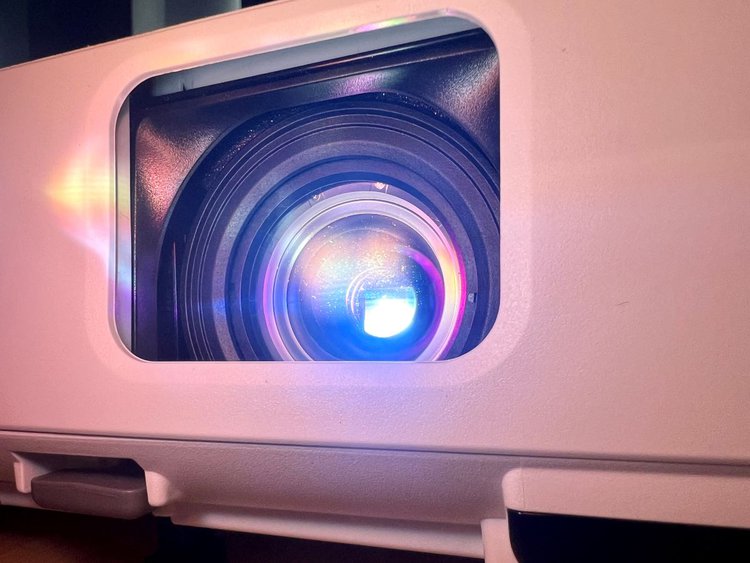
- Activate ECO mode to reduce noise, keep the room cool, ensure good ventilation, and turn off Auto Iris mode to minimize projector sound.
- Regularly clean the projector’s components, maintain a suitable distance from the projector, and secure its mounting to decrease noise.
- Lower the laptop’s refresh rate when connected to the projector, use sound-absorbing materials in the room, and consider a hush box for significant noise reduction.
A projector’s noises are usually a result of its moving parts (e.g., mirror away, RGB wheel, lens) or its fan spinning.
All these parts are essential to your projector’s functionality, but still, a projector that’s too loud or making a buzzing noise can disrupt your viewing experience.
This article will guide you through simple, effective ways to quiet down your noisy projector and enhance your movie nights.
Quick Navigation
- 1. Turn Your Projector’s ECO Mode ON
- 2. Keep Your Room Cool Enough
- 3. Ensure Your Projector Is Well-Ventilated
- 4. Turn Off the Auto Iris Mode
- 5. Have Your Projector Cleaned
- 6. Have a Certain Distance Between You and Your Projector
- 7. Mount Your Projector Properly
- 8. Lower Your Laptop’s Refresh Rate
- 9. Pad the Floors and Walls
- 10. Put the Projector in a Hush Box
- Wrapping Things Up
1. Turn Your Projector’s ECO Mode ON
Out of the box, your projector is set to Normal mode, which uses more power to ensure your unit emits a brighter, high-quality image.
While Normal mode is good if you need your projector to be as bright as possible (e.g., if you’re using it in ambient lighting), its excess power usage can result in a loud whirring noise.
ECO mode decreases your unit’s power consumption, lowers its brightness capacity, consequently elongating its lamp life, and makes your unit quieter.
That said, I suggest only enabling ECO mode once you’ve used your projector for at least 50 hours. Otherwise, you could encounter an equally frustrating flickering issue.
Follow the directions below to enable ECO mode on an Epson projector.
Step 1: Click the Menu button on your projector’s control panel.
Step 2: Navigate to ECO.
Step 3: Head to Power Consumption and change it to ECO.

Step 4: Next, navigate to ECO Display and toggle it On.
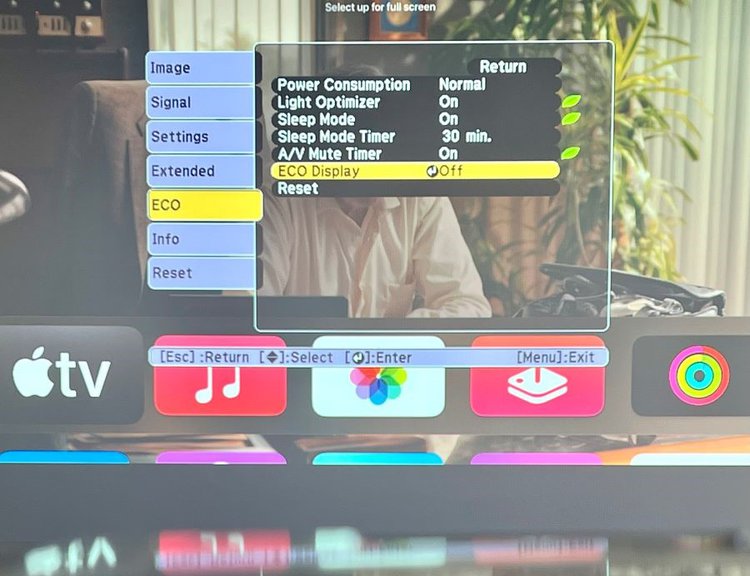
2. Keep Your Room Cool Enough
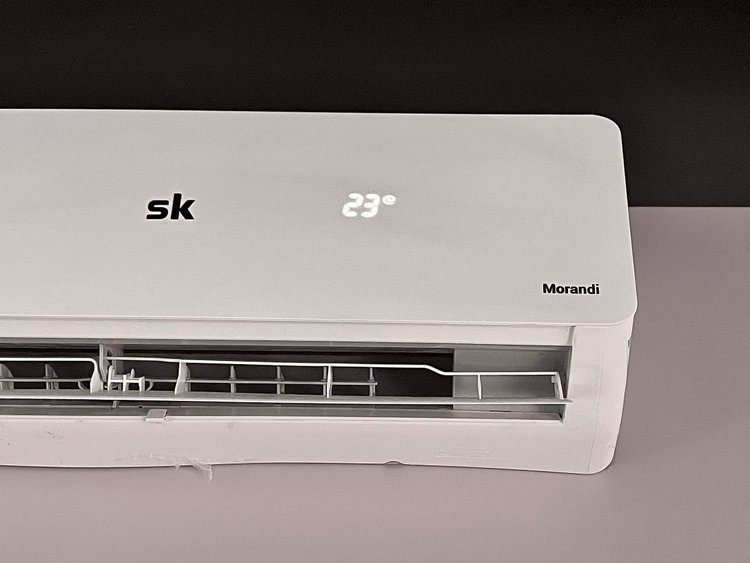
Projectors produce a very bright light, and consequently, generate a lot of heat both from their internal components working and the light source.
So, all projectors are fitted with a cooling fan to help keep the unit nice and chilly. This fan is imperative to your projector’s functionality, as it would indeed shut down without it.
When your projector is hot, the cooling fan must work overtime to keep its temperature leveled. However, when your projector is already cool, the fan can spin at a slower rate, making less noise.
So, to ensure your projector’s fan doesn’t have to spin 100 miles an hour to prevent overheating, keep your room cool by cracking a window or turning on the AC. You may also want to ensure your projector isn’t right next to a heating appliance.
23 to 27 degrees Celcius (73 to 80 degrees Fahrenheit) is generally the recommended temperature for projectors.
However, if your unit is very hot to the touch, I recommend unplugging it for a few minutes to let it cool off and halt the overheating process.
3. Ensure Your Projector Is Well-Ventilated
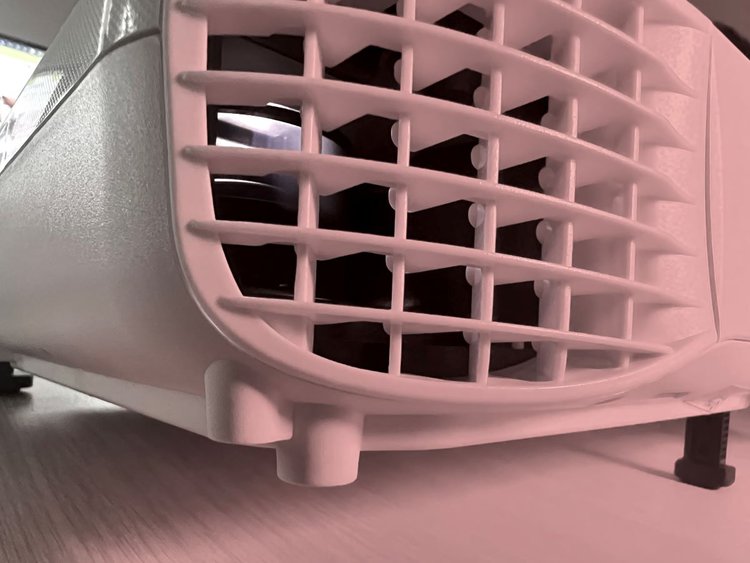
As discussed in the above solution, it’s not uncommon for projectors to overheat as they create copious amounts of light.
While keeping your projector cool will prevent its fan from overworking (and thus creating a loud noise), it’s also important to ensure your unit is well-ventilated.
If you examine your projector, you’ll see its vent holes or slits along the bottom and sides of it. These vents allow the inner components to receive cool air while also expelling any hot air that may have become trapped inside the unit.
If any of these vents are blocked, your projector will be unable to cool its inner components, causing the fan to work harder and create more noise.
I also suggest regularly cleaning the vents, as they collect dust which can hinder your projector’s ventilation. Every projector brand recommends different cleaning methods, so consult your unit’s manual for more information. You may also need to clean or replace the projector’s filters, which we outline how to do in solution #5.
When setting up your projector, make sure to leave at least 50cm of empty space around each side to avoid blocking any vents.
Most projector brands also recommend avoiding placing them on any soft surfaces like rugs, carpets, beds, sofas, tablecloths, etc., as these materials can block circulation.
4. Turn Off the Auto Iris Mode
If your projector hasn’t overheated and the sound doesn’t seem to be emanating from its fan, it may be coming from its lens instead.
As many projector users have found, this noise, which sounds like a DSLR camera, may arise when you adjust your projector lens.
Just like cameras, projectors also have lenses that are used to control the amount of light projected onto a screen. These lenses can be adjusted to focus the image, resize it, and make other important changes.
Many projectors have an Auto Iris mode which automatically opens the lens’ iris during bright scenes (to let out more light) and closes it during dark scenes. While this mode is helpful for creating impeccable images on-screen, it can cause your unit to make some strange, loud noises.
Naturally, disabling Auto Iris mode will help diminish these noises as the lens will not be constantly opening and moving, staying still and silent.
This process will vary depending on your projector brand and model, but to get you started, we’ve outlined how to disable this mode on an Epson projector.
Step 1: Press your projector’s Menu key.
Step 2: Head to the Image option.
Step 3: Head to Auto Iris before toggling it Off.
Now continue using your projector to see if the issue has been resolved.
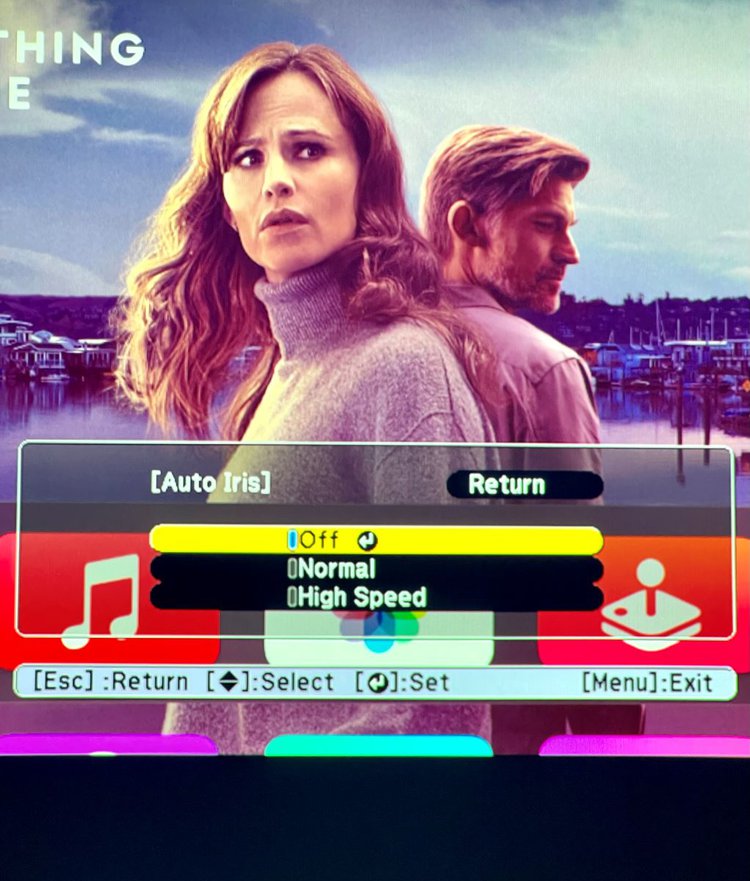
5. Have Your Projector Cleaned
Dirty projectors can cause a host of problems, including loud noises as a result of overheating. So, it’s imperative to keep all of your projector’s components clean as this will ensure those pesky dust particles won’t create any cringe-worthy noises.
However, cleaning your unit can be a delicate process. Luckily, I’ve compiled a short guide on how to clean your projector’s various components without damaging them.
Clean Your Projector’s Lens
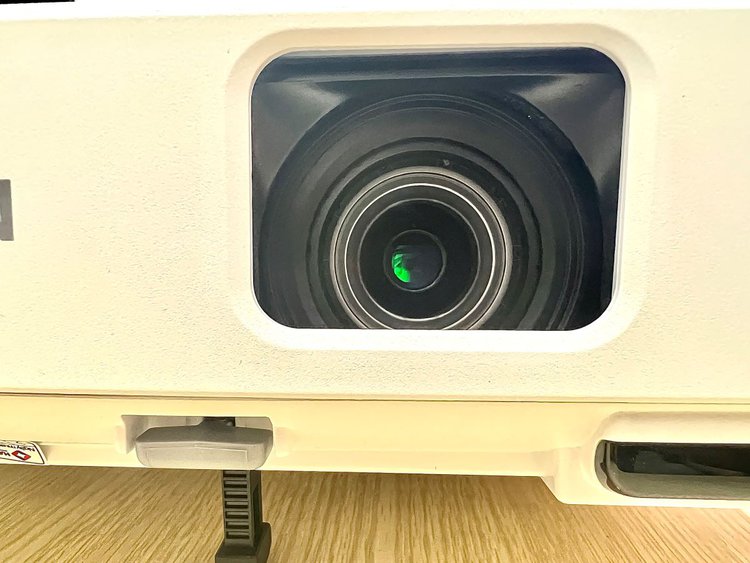
As previously discussed, a projector’s lens is crucial to the unit’s light output. Consequently, when the lens is dusty, your projector may struggle to adjust its aperture and emit light normally as the lens is partially blocked by debris. As your projector tries (and fails) to emit its desired light output, it can overheat and create loud noises.
Not to mention, the dust will decrease the unit’s Lumen output, making the image appear dimmer and cloudier than usual. This can also cause your unit’s lamp life to expire prematurely.
So, to avoid these issues, it’s best to clean the lens on a regular basis.
Projector lenses are extremely delicate, and can’t be cleaned the same way you’d clean other glass objects, like your eyeglasses.
Follow the steps below to clean your projector lens.
Materials Needed
- Compressed air
- Lens cloth
- Non-abrasive lens cleaner
Instructions
Step 1: Turn off the projector and, once its cooling fan has stopped spinning, unplug it from power. Then, wait for it to completely cool. Remember, the lens will be very hot, so you need to let it cool before cleaning it to avoid burning yourself.
Step 2: Hold a can of compressed air about seven inches away from the lens, and release small bursts to blow away the dust. Be careful not to hold the can too close to the lens, as the air’s pressure could crack it.
Step 3: If your lens is clean after removing the dust, then you’re ready to start using it again. However, if you see any smudges or fingerprints on it, then it’s best to clean it using a lens cloth and non-abrasive lens cleaner. Dot a small amount of lens cleaner onto the cloth and gently wipe the lens off. Make sure the lens is streak-free before replacing the lens cap.
Watch the video below demonstrating how to properly clean the projector lens.
Clean Your Projector Filter
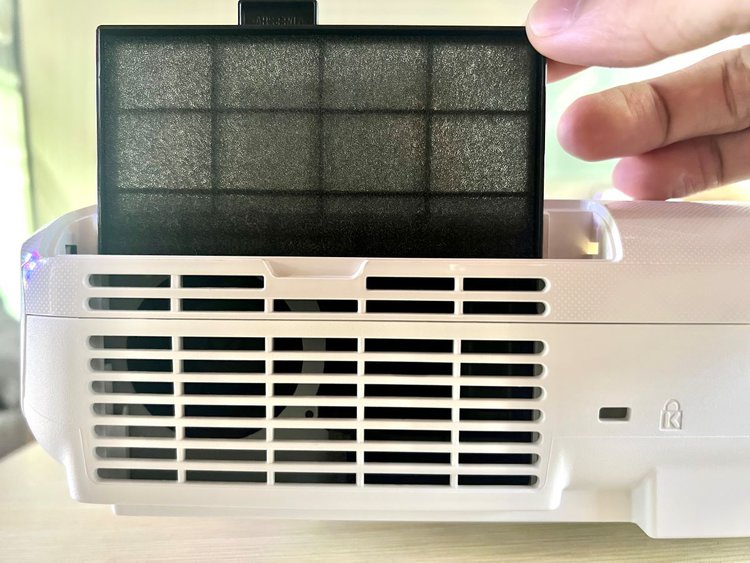
Projectors have a thin filter behind their vent slots that catch dust, preventing it from coating the unit’s internal components.
Over time, these filters can become clogged, preventing the projector from receiving proper ventilation, especially if you’ve used your unit for years without ever cleaning it. A lack of ventilation can cause overheating and, consequently, a loud noise coming from your projector.
These filters are very sensitive and prone to tears, so they must be cleaned very delicately to avoid damaging them.
Follow the steps below to clean your projector filter.
Step 1: Before cleaning the filter, you have to find it. Look through your projector’s various grates until you find one with a filter behind it. You may want to use a flashlight for this step.
Step 2: Once you’ve found the grate covering the filter, it’s best to clean it before opening it to prevent any dust from entering the projector. Use a vacuum on the lowest suction level to gently remove any dust or debris.
Step 3: Now that the grate is clean, you’re ready to remove the filter. There should be a latch on top of the filter, which can be swung opened or unscrewed. Remove the latch and, if it was screwed in place, be sure not to lose any of the screws.
Step 4: Gently remove the filter from its slot. It should slide right out with little force.
Step 5: Use a vacuum to suck off any dust. You may also use the vacuum brush to gently brush away the debris before removing it. If you find the filter is too dirty to sufficiently clean or is covered in a strange substance (e.g., is sticky), you may want to replace the filter altogether. You can order filter replacements online, and they’re usually modestly priced.
Step 6: Now that your filter is clean, pop it back into the projector and replace the hatch.
Watch the video below demonstrating how to clean a projector filter using the method listed above.
Clean Your Projector Fan
Last, but certainly not least, it’s a good idea to clean your projector fan. Dirty fans may struggle to spin as efficiently and, as we’ve mentioned several times, the dust can cause your unit to overheat.
Since different projector brands use various fan types, it’s best to follow your projector model’s specific instructions. For some brands, you may need to open the projector’s hardware to access the fan, which can be a complicated and lengthy process.
To help get you started, check out our guide to cleaning a BenQ fan, iFixit’s guide for a Toshiba projector fan, or this YouTube video demonstrating how to clean an XGIMI projector fan.
If you have a different projector brand, I recommend finding its user manual on the brand’s official website.
6. Have a Certain Distance Between You and Your Projector
At the end of the day, all projectors will make some noise, be it from their cooling fans or lenses. Even when your projector is in the best condition possible, you will likely still hear a soft hum coming from it.
So, if you’ve followed all the solutions listed above and can still hear your projector, it may be best to sit a little further away from it. This distance will allow you to only hear the content’s audio as opposed to your projector’s inner mechanisms.
BenQ recommends sitting between 3.3 to 6.6 ft. away from your projector to avoid hearing its cooling fan working while watching content.
7. Mount Your Projector Properly
If mounted incorrectly, your projector may shake as it works. For instance, if your unit is loosely mounted to the ceiling, it may vibrate as it’s not securely bolted in place.
This constant movement can lead to the fan creating excess amounts of noise, leading to a very loud viewing experience.
So, carefully examine your projector’s mount, and ensure all screws and bolts are sufficiently tightened. Also, make sure you’re using a compatible mount for your unit, as any ill-fitting mounts will cause it to vibrate and make loud noises. Not to mention, you risk your projector falling from the mount and injuring someone.
8. Lower Your Laptop’s Refresh Rate
A projector’s refresh rate is how quickly your unit displays a new image per second. Although you may need a high refresh rate if you’re gaming, you can lower it for casual viewing.
Your projector works hard to constantly display new images and quickly heats up, which as we know, makes noise.
So why not give it a break? Your projector and ears will both thank you.
When lowering the refresh rate, try setting it to 40Hz first before decreasing it even more.
You can lower the refresh rate on your laptop connected to the projector via an HDMI cable. Follow the instructions below to change the refresh rate on your Windows or MacBook Pro laptop.
How to Lower the Refresh Rate on Windows
Follow the steps below to lower the refresh rate on a Windows laptop/computer.
Step 1: Click the Start/Windows button.
Step 2: Open the Settings.
Step 3: Go to System.
Step 4: Click Display.
Step 5: Select Advanced Display, and then choose a lower refresh rate and save your changes.
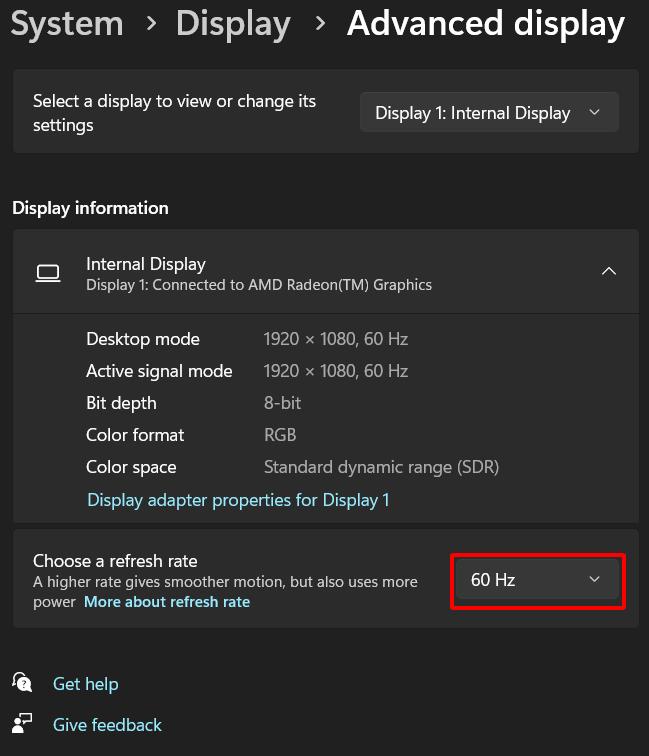
How to Lower the Refresh Rate on a MacBook Pro
Only 14 and 16-inch MacBook Pros have the option of changing the refresh rate.
See the steps below to change the refresh rate on a Macbook Pro.
Step 1: Click on the Apple menu in the top left corner of your screen.
Step 2: Select System Preferences.
Step 3: Open Displays, and select a lower refresh rate from the drop-down list.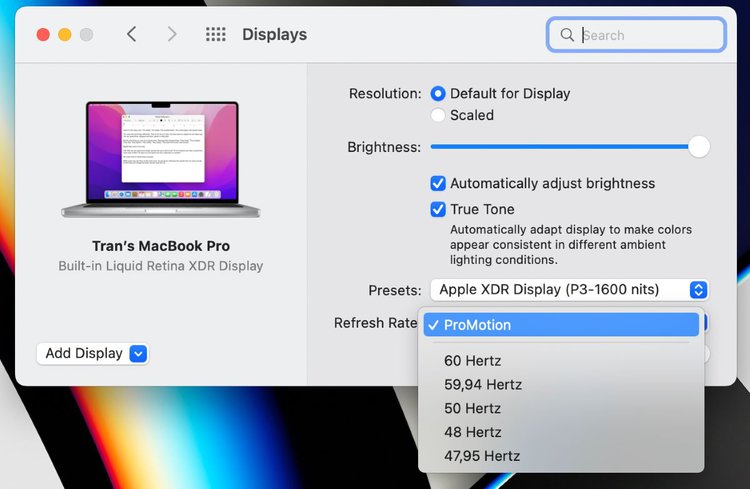
9. Pad the Floors and Walls
Bare surfaces reverberate more sound, so try covering your floors and walls, so you won’t hear your projector’s sound echoing.
You can place a few soundproofing panels on the wall to absorb any sound your projector emits. If you’re in the market for some soundproofing panels, check out the JBER 12 Pack Acoustic Foam Panels on Amazon.
If soundproofing panels don’t quite go with your aesthetic, don’t worry. There’s another, more stylish solution. Try using some rugs, curtains, or tapestries to insulate the room.
Not only will this make your home theater cozy, but it will also ensure you only hear your projector’s speakers, not its fan.
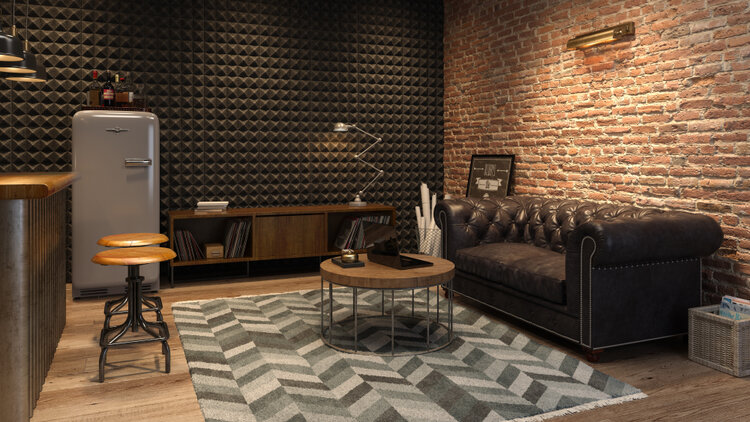
10. Put the Projector in a Hush Box
Hush boxes silence your projector’s noise by keeping it contained.
This is the last option because hush boxes are difficult to find online, but they also block airflow, which can cause your projector to overheat.
However, they may be a good solution if you’ve tried all the above suggestions and still cannot silence your projector.
When looking for a hush box, you’ll want to make sure it has a quiet internal fan unit to keep your projector cool.
If you’re crafty, you can build the hush box yourself using wood, soundproof paneling, and a fan.
ProjectsandThings on YouTube has a great video demonstrating how to make your own DIY hush box.
Wrapping Things Up
Noisy projectors are a nuisance, but they’re usually a result of something minor, like a disabled ECO mode and enabled Auto Iris mode.
Poor ventilation, and a dirty lens, filter, or fan can also cause your projector to overheat, leading to the fan overworking and making a loud whirring noise.
So, make sure to keep your environment cool enough and your projector clean to ensure it stays as quiet as possible.
However, in some cases, the best solution may be to move away from your projector so you can’t hear its inner components working.
It’s also a good idea to check that the unit is securely mounted and not rattling, which would create a loud noise.
What’s your experience with your projector making a loud noise, and how were you able to fix it?
Let us know in the comments below!
Yesenia Achlim is a technical copywriter and editor with a focus on AV equipment. She aims to break down complicated topics and make technology accessible, no matter your technical expertise. When she’s not teaching you how to replace a projector lamp, you can find her reading and baking.


